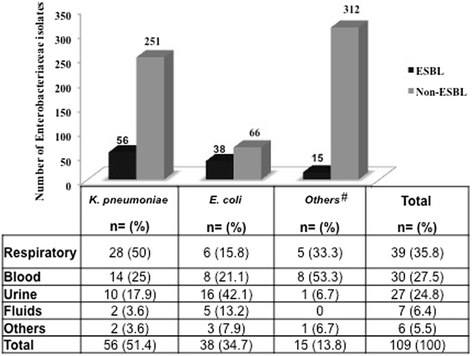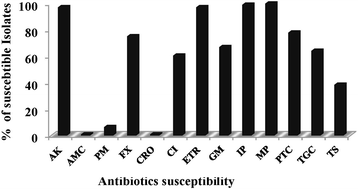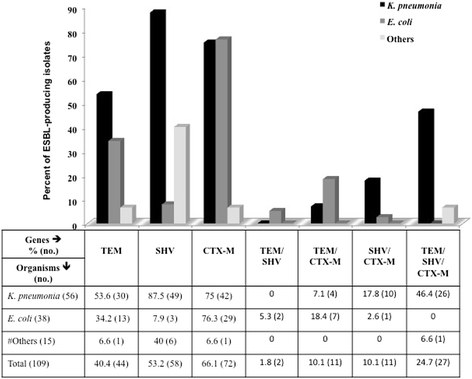Antimicrobial susceptibility and molecular epidemiology of extended-spectrum beta-lactamase-producing Enterobacteriaceae from intensive care units at Hamad Medical Corporation, Qatar
- PMID: 26865975
- PMCID: PMC4748476
- DOI: 10.1186/s13756-016-0103-x
Antimicrobial susceptibility and molecular epidemiology of extended-spectrum beta-lactamase-producing Enterobacteriaceae from intensive care units at Hamad Medical Corporation, Qatar
Abstract
Background: The emergence of extended-spectrum beta-lactamase (ESBL)-producing isolates has important clinical and therapeutic implications. High prevalence of ESBL-producing Enterobacteriaceae has been reported in the literature for clinical samples from a variety of infection sites. The present study was undertaken to evaluate the prevalence of ESBL-producing Enterobacteriaceae, and to perform molecular characterization and antimicrobial susceptibility testing of clinical isolates from patients admitted to the intensive care units at Hamad Medical Corporation, Doha, Qatar, from November 2012 to October 2013.
Methods: A total of 629 Enterobacteriaceae isolates were included in the study. Identification and susceptibility testing was performed using Phoenix (Becton Dickinson) and the ESBL producers were confirmed by double-disk potentiation as recommended by the Clinical and Laboratory Standards Institute. Molecular analysis of the ESBL producers was performed by polymerase chain reaction.
Results: In total, 109 isolates (17.3 %) were confirmed as ESBL producers and all were sensitive to meropenem in routine susceptibility assays. Most of the ESBL producers (99.1 %) were resistant to amoxicillin/clavulanic acid and ceftriaxone and 93.6 % were resistant to cefepime. Among the ESBL-producing genes, bla CTX-M (66.1 %) was the most prevalent, followed by bla SHV (53.2 %) and bla TEM (40.4 %).
Conclusions: These findings show the high prevalence of ESBL-producing Enterobacteriaceae within the intensive care units at Hamad Medical Corporation, Qatar, and emphasize the need for judicious use of antibiotics and the implementation of strict infection control measures.
Keywords: Antimicrobial Susceptibility; Extended-spectrum beta-lactamase; Gram-negative bacteria; Molecular epidemiology; Qatar.
Figures



Similar articles
-
Molecular characterization of extended-spectrum beta-lactamases and its correlation with clinical laboratory standards institute interpretive criteria for disk diffusion susceptibility testing in enterobacteriaceae isolates in Thaialnd.Southeast Asian J Trop Med Public Health. 2012 Nov;43(6):1461-9. Southeast Asian J Trop Med Public Health. 2012. PMID: 23413710
-
Molecular characteristics of extended-spectrum β-lactamases in clinical isolates of Enterobacteriaceae from the Philippines.Acta Trop. 2011 Oct-Nov;120(1-2):140-5. doi: 10.1016/j.actatropica.2011.07.007. Epub 2011 Jul 28. Acta Trop. 2011. PMID: 21820398
-
Relationship between the distribution of cefepime minimum inhibitory concentrations and detection of extended-spectrum β-lactamase production among clinically important Enterobacteriaceae isolates obtained from patients in intensive care units in Taiwan: results from the Surveillance of Multicenter Antimicrobial Resistance in Taiwan (SMART) in 2007.J Microbiol Immunol Infect. 2015 Feb;48(1):85-91. doi: 10.1016/j.jmii.2013.07.002. Epub 2013 Aug 22. J Microbiol Immunol Infect. 2015. PMID: 23973410
-
Predominance and genetic diversity of community- and hospital-acquired CTX-M extended-spectrum beta-lactamases in York, UK.J Antimicrob Chemother. 2004 Sep;54(3):628-33. doi: 10.1093/jac/dkh397. Epub 2004 Aug 4. J Antimicrob Chemother. 2004. PMID: 15294889
-
First report on the occurrence of SHV-12 extended-spectrum beta-lactamase-producing Enterobacteriaceae in the Philippines.J Microbiol Immunol Infect. 2009 Feb;42(1):74-85. J Microbiol Immunol Infect. 2009. PMID: 19424562
Cited by
-
Emergence of Multidrug- and Pandrug- Resistant Pseudomonas aeruginosa from Five Hospitals in Qatar.Infect Prev Pract. 2019 Nov 23;1(3-4):100027. doi: 10.1016/j.infpip.2019.100027. eCollection 2019 Dec. Infect Prev Pract. 2019. PMID: 34368684 Free PMC article.
-
Spread of resistant gram negatives in a Sri Lankan intensive care unit.BMC Infect Dis. 2017 Jul 11;17(1):490. doi: 10.1186/s12879-017-2590-7. BMC Infect Dis. 2017. PMID: 28697755 Free PMC article.
-
Phage vB_Ec_ZCEC14 to treat antibiotic-resistant Escherichia coli isolated from urinary tract infections.Virol J. 2024 Feb 16;21(1):44. doi: 10.1186/s12985-024-02306-0. Virol J. 2024. PMID: 38365702 Free PMC article.
-
Molecular characterization of extended spectrum β -lactamases enterobacteriaceae causing lower urinary tract infection among pediatric population.Antimicrob Resist Infect Control. 2018 Jul 28;7:90. doi: 10.1186/s13756-018-0381-6. eCollection 2018. Antimicrob Resist Infect Control. 2018. PMID: 30069306 Free PMC article.
-
Co-Existence of Certain ESBLs, MBLs and Plasmid Mediated Quinolone Resistance Genes among MDR E. coli Isolated from Different Clinical Specimens in Egypt.Antibiotics (Basel). 2021 Jul 9;10(7):835. doi: 10.3390/antibiotics10070835. Antibiotics (Basel). 2021. PMID: 34356756 Free PMC article.
References
LinkOut - more resources
Full Text Sources
Other Literature Sources
Molecular Biology Databases

